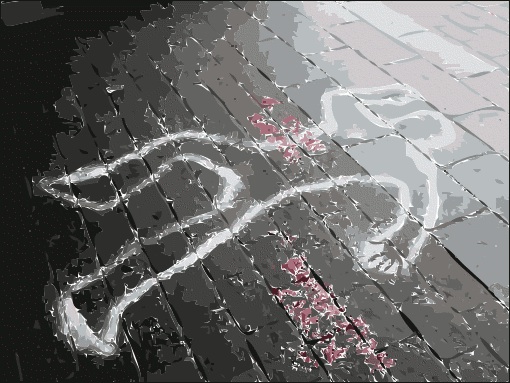Let me start by saying this is an interesting time, around our house. As of this writing, our third child (and only daughter) is expecting her first baby, and since he (it's a boy) is due shortly, it means my wife Carolyn and I are expecting as well. Every time the phone rings, Carolyn jumps like she just sat on a cactus plant.
Less important but still stressful is the fact that my fourth book is due to be released next week. (I've already done one signing, in my hometown some seventy miles north of us; the "official" launch of the book here in the Jackson area will be a signing and reading at Lemuria Bookstore this coming Wednesday.) Why should that be stressful, at this point? Well, because my publisher has arranged a boatload of signings and interviews over the coming days and weeks, and with a new grandchild about to make his appearance we could have some last-minute scheduling conflicts.
Taking up the collection
Writingwise, this book--it's called Deception--didn't require a lot of work, because it's a collection of thirty of my short stories, and twenty-eight of those stories were previously published. The actual writing was of course done some time ago, before the individual stories were originally sold to magazines and anthologies. But--believe it or not--the task of arranging stories into a collection can be harder than most folks realize. The very fact that they were written at different times and for different markets can make it difficult for them to exist together in the same volume.
My first book, Rainbow's End (2006), included thirty of my previously published stories; Midnight (2008) had thirty more; Clockwork (2010) had forty. The latest book, Deception (2013), again contains thirty stories, only two of which are new and have not been previously published. Those two original stories were included not because I'm running out of inventory for reprints but because the publisher felt it would be a good idea to (for the first time) throw a couple of new ones into the mix. I've already picked out thirty more stories for a fifth collection in case the publisher eventually decides to go through the mental and financial anguish of producing another one.
The good thing about including only pre-pubbed stories in a collection is that those usually don't require much editing. If they were good enough to sell (depending of course on where they sold), they're probably good enough to be reprinted. The bad thing is that, as I said earlier, there are a few more things to think about than whether the individual stories are properly written.
Writers' guidelines
Here are some of the points (rules?) that my publisher and I had to consider, for each collection of stories. (By the way, he allowed me far more input into the process than an author usually gets, and I'm grateful for that.)
2. Vary the moods and intensity levels of the stories. We tried to arrange the sequence such that there's a mix of lighthearted vs. gritty subject matter.
3. Choose a theme. All the included stories should have something, however small, in common. Setting, characters, genre, etc. In my case, that was easy: all of them involve mystery/suspense.
4. Don't repeat character names (unless the stories are part of a series). Since most of these stories were originally written to "stand alone," we had to make sure we didn't accidentally place a story featuring, let's say, a protagonist named Jerry alongside another story featuring a protagonist named Jerry. In fact we tried to limit the occurrence of any characters having the same first or last names, especially if the names were unusual. When we did find repeated names--unless they were series characters--most of them got changed. I discovered that for some reason I seem to have an odd fondness for first names like Charlie, Jack, Lucy, Eddie, and a few others, and I use them too often.
5. Don't group other genres or subgenres within the book. Even though almost all these stories can be classified as mystery/crime/suspense, they're sometimes cross-pollinated with other categories, like fantasy, humor, Western, romance, horror, or even sci-fi. And we didn't want the reader encountering several space operas (or horse operas) back-to-back.
6. Don't allow pet phrases to sneak in. I came to realize that I often use expressions like "heaved a sigh" and "as pale as chalk" and "stomped into the room" in more than one story. When that kind of thing happens, and you put those stories together in a collection, the repetition of those phrases sounds almost as bad as it might be if you repeated them in the same story. Bottom line is, we went through and tried to catch those "favorite" and overused phrases and change them up a bit. I became extremely familiar with, and grateful for, the search utility in MS Word.
7. Pick appropriate stories to open and close the collection. For each book we've tried to start out with a story that was both engaging and typical, to set the stage for what follows. We also tried to close with a story that was in some way especially memorable. I think it was Mickey Spillane who said the first chapter sells the book and the last chapter sells the next book. The same thing applies to the stories in a collection of shorts.
8. Vary the crimes. Since these are mysteries, we made sure not to create clusters of stories that featured the same crime: murder, robbery, kidnapping, and so forth. With the first book, we almost didn't catch the fact that two jewelry heists were featured back-to-back. If we'd left them that way, readers would certainly have found that distracting.
10. Finally, we decided not to group stories that had been previously published in the same magazine. In other words, we put some space between stories sold in The Strand, AHMM, or wherever. The only exception to this occurred with some of the "series" mysteries I'd written for Woman's World. Each book so far has featured between six and eight of those mini-mysteries (which use recurring characters), and we've always placed those together, one right after the other, in the exact center of the book. I can't tell you why we did that, except that it just felt right.
One for all or all for one
Some of the points mentioned above also come into play if one is editing an anthology rather than a collection, but the placement of the stories and the avoidance of repetition isn't quite as difficult for anthologies because those stories are--by definition--written by different authors. Pet phrases and duplicate character-names obviously don't happen as often when different authors are involved. In the case of a mystery anthology that I edited several years ago--it included our own Liz Zelvin, Herschel Cozine, and Deborah Elliott-Upton--my main concern was making sure that stories with certain crimes and certain "moods" didn't get grouped too closely together. And I also tried to maintain a good mix of short vs. long, and to choose appropriate stories to begin and close the book.
Have any of you had to wrestle with these kinds of choices? (If you've put together an anthology you probably have, or if you've been allowed some "say" in the process of creating a collection of your own work.) If so, what are your thoughts on the subject? Did you find the selection and placement of the stories difficult? Challenging? Frustrating? How big a task was it to update and retrofit and otherwise edit the stories themselves? Did you run into any issues I haven't mentioned?
Regardless of the difficulties, we probably agree on one thing: it's worth the trouble.









 Like most writers I love reading. I guess I could be perfectly happy reading all day every day. I loved reading so much that my late husband, Elmer and I opened a bookstore in Austin in 1990. We titled it Mysteries and More. The "more" part was because we also had science-fiction, western, and general fiction. But all of those genre were used books. The new books were all mysteries and we had a huge number of used mysteries. I used to say we had 75% used and 25% new books. That was probably accurate. M & M was only the second mystery bookstore in Texas. Murder by the Book was the first and I think it's the only one currently still in business.
Like most writers I love reading. I guess I could be perfectly happy reading all day every day. I loved reading so much that my late husband, Elmer and I opened a bookstore in Austin in 1990. We titled it Mysteries and More. The "more" part was because we also had science-fiction, western, and general fiction. But all of those genre were used books. The new books were all mysteries and we had a huge number of used mysteries. I used to say we had 75% used and 25% new books. That was probably accurate. M & M was only the second mystery bookstore in Texas. Murder by the Book was the first and I think it's the only one currently still in business. 










